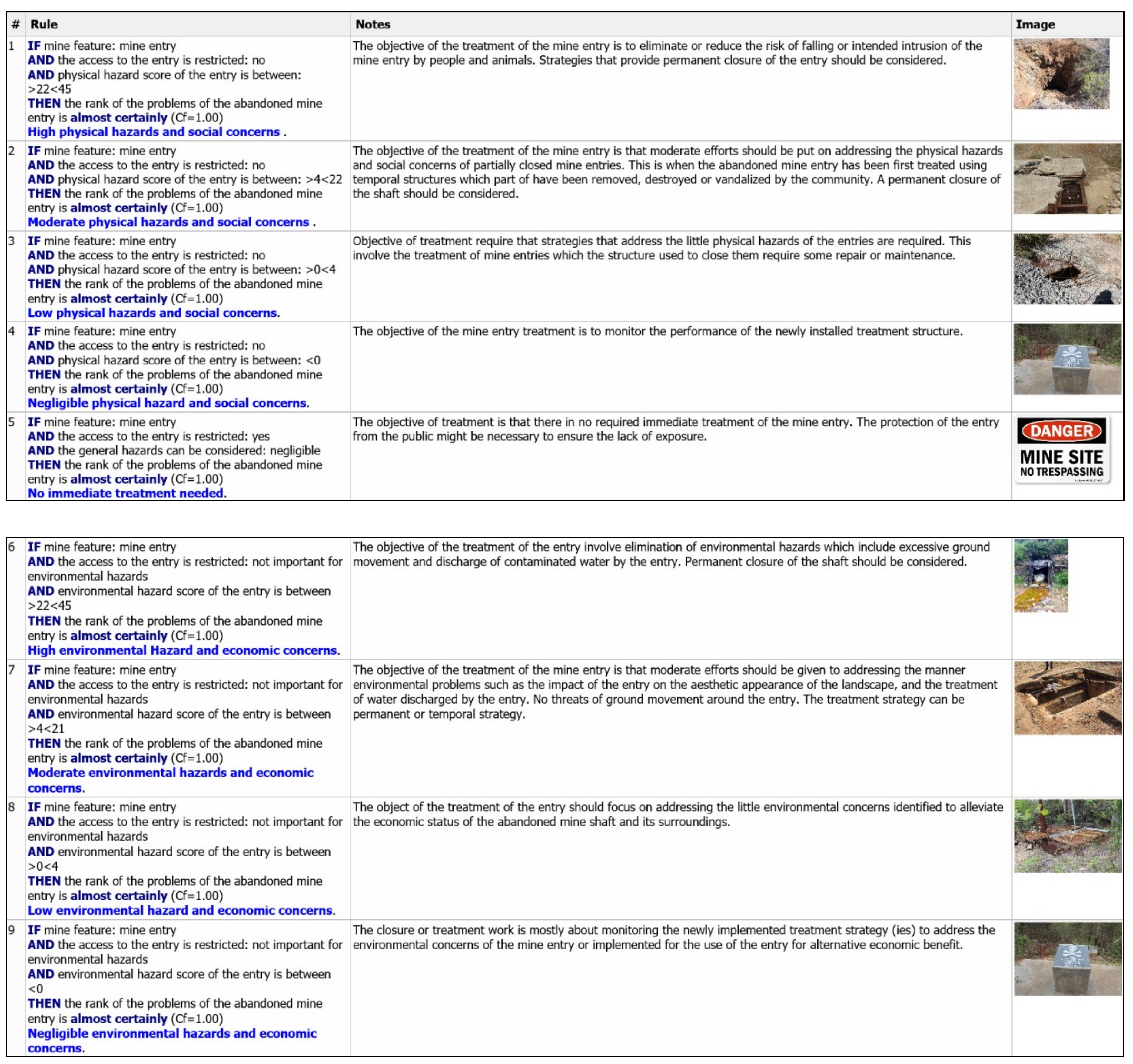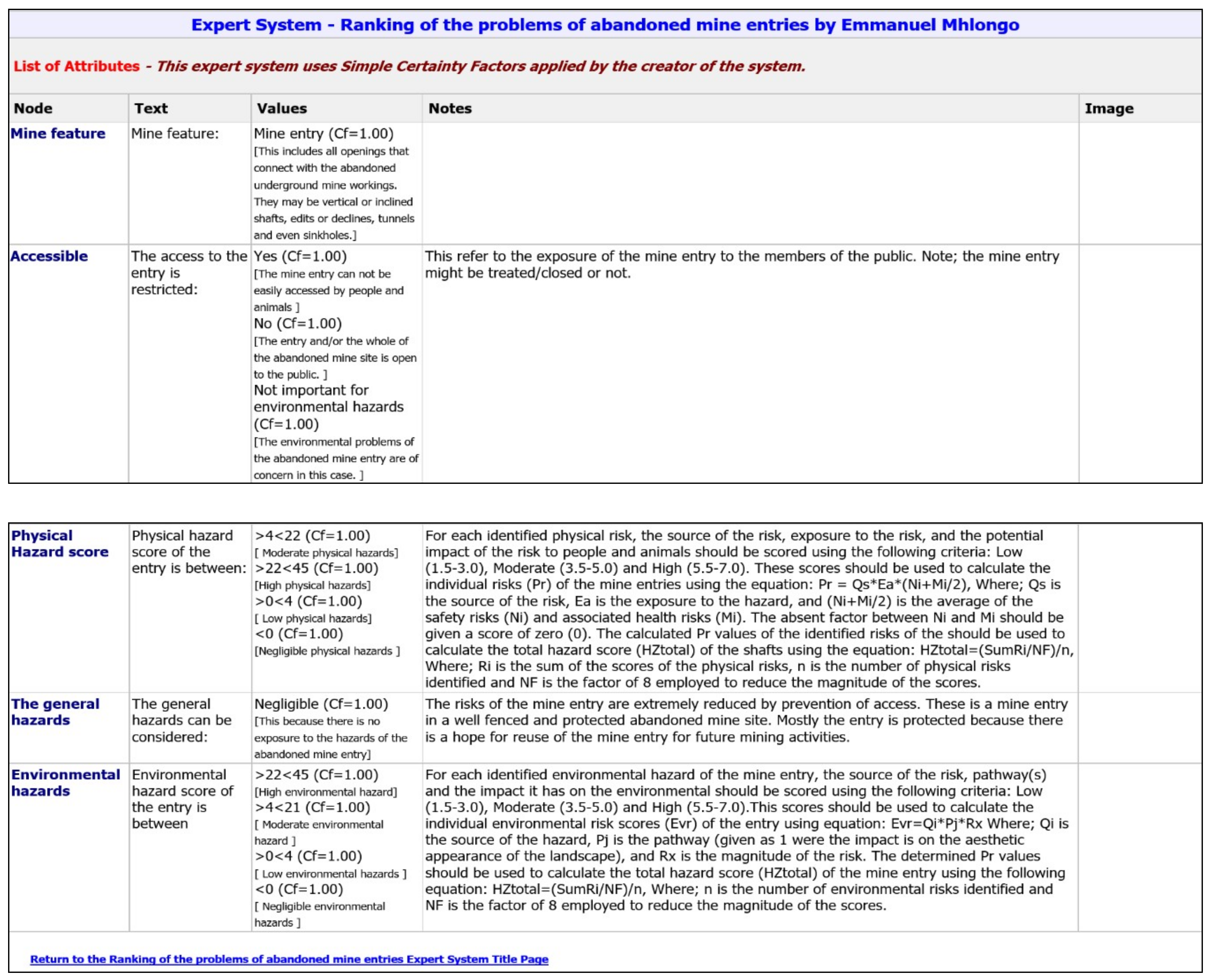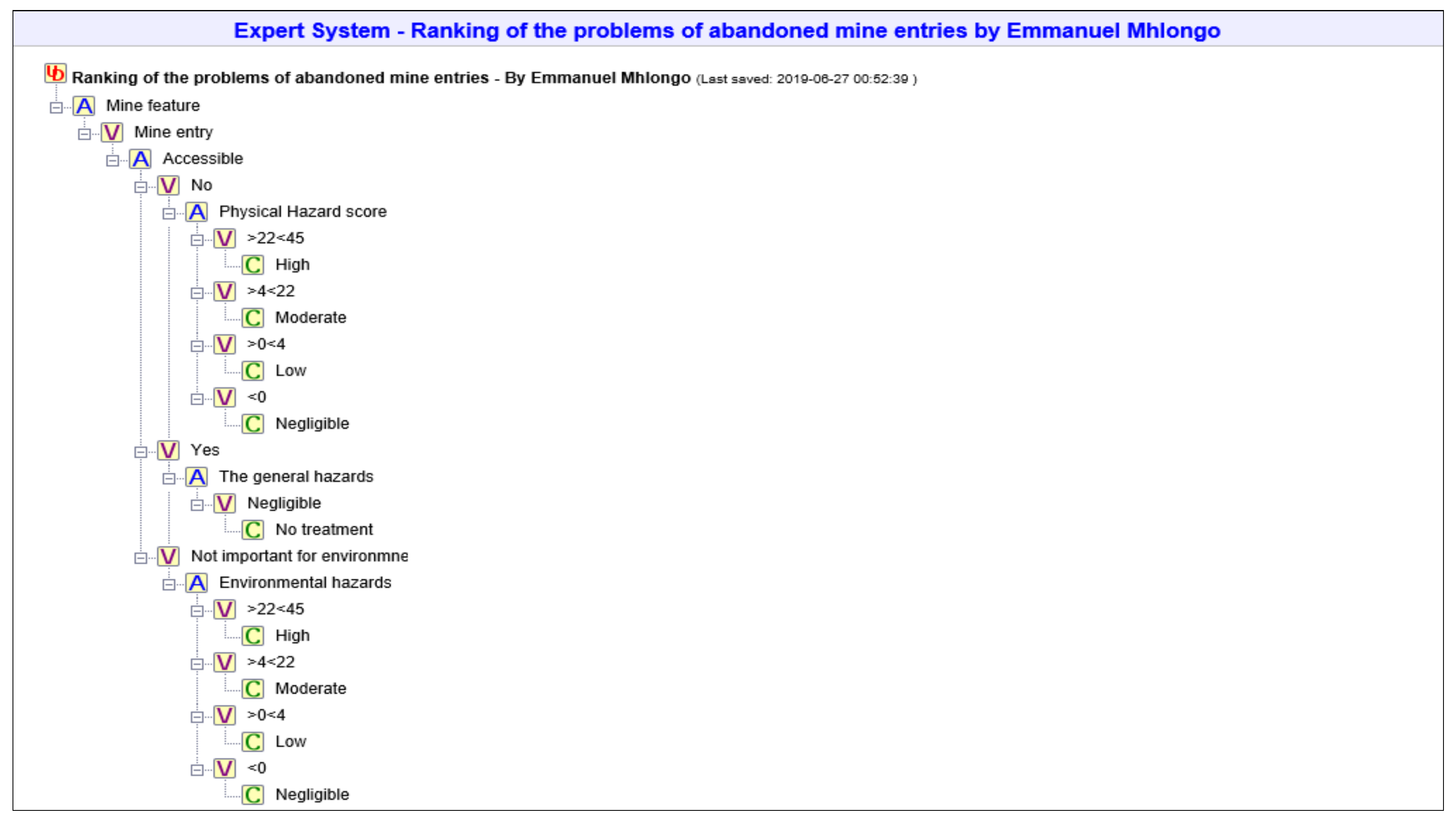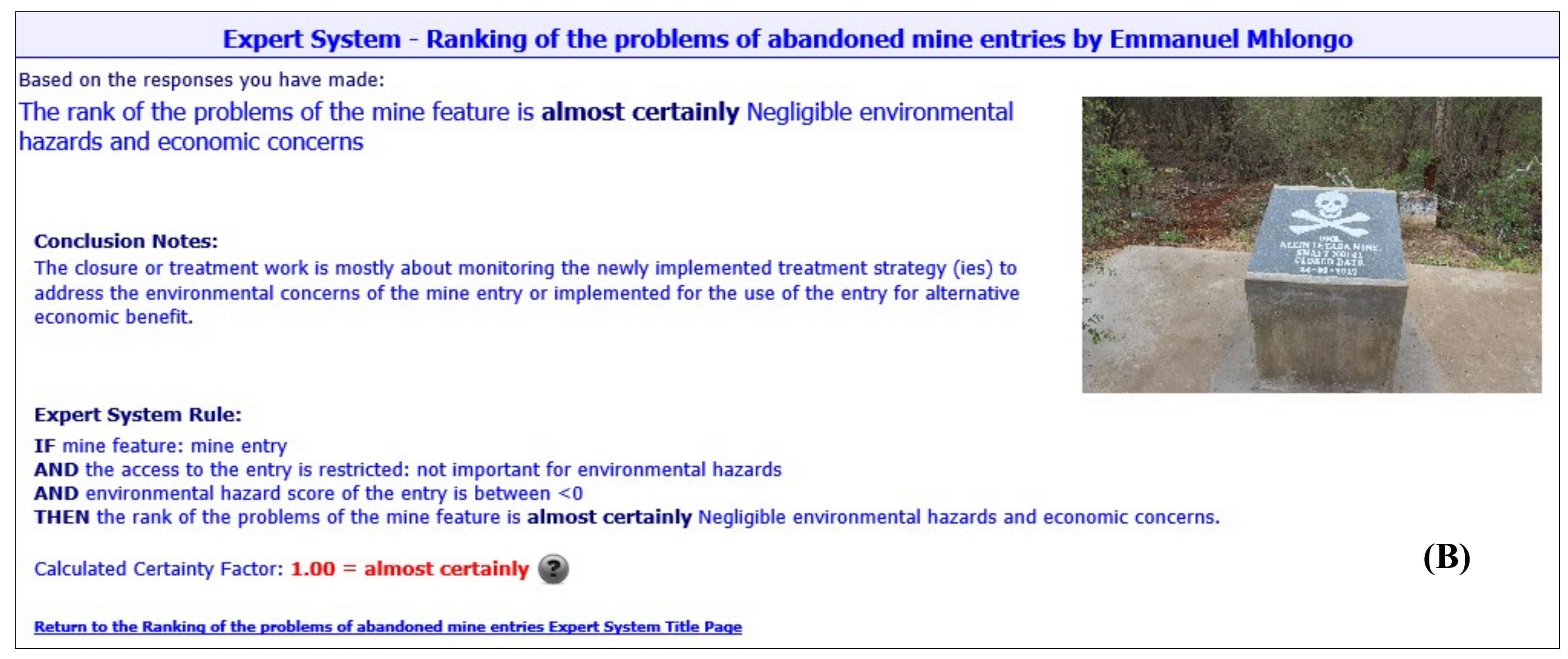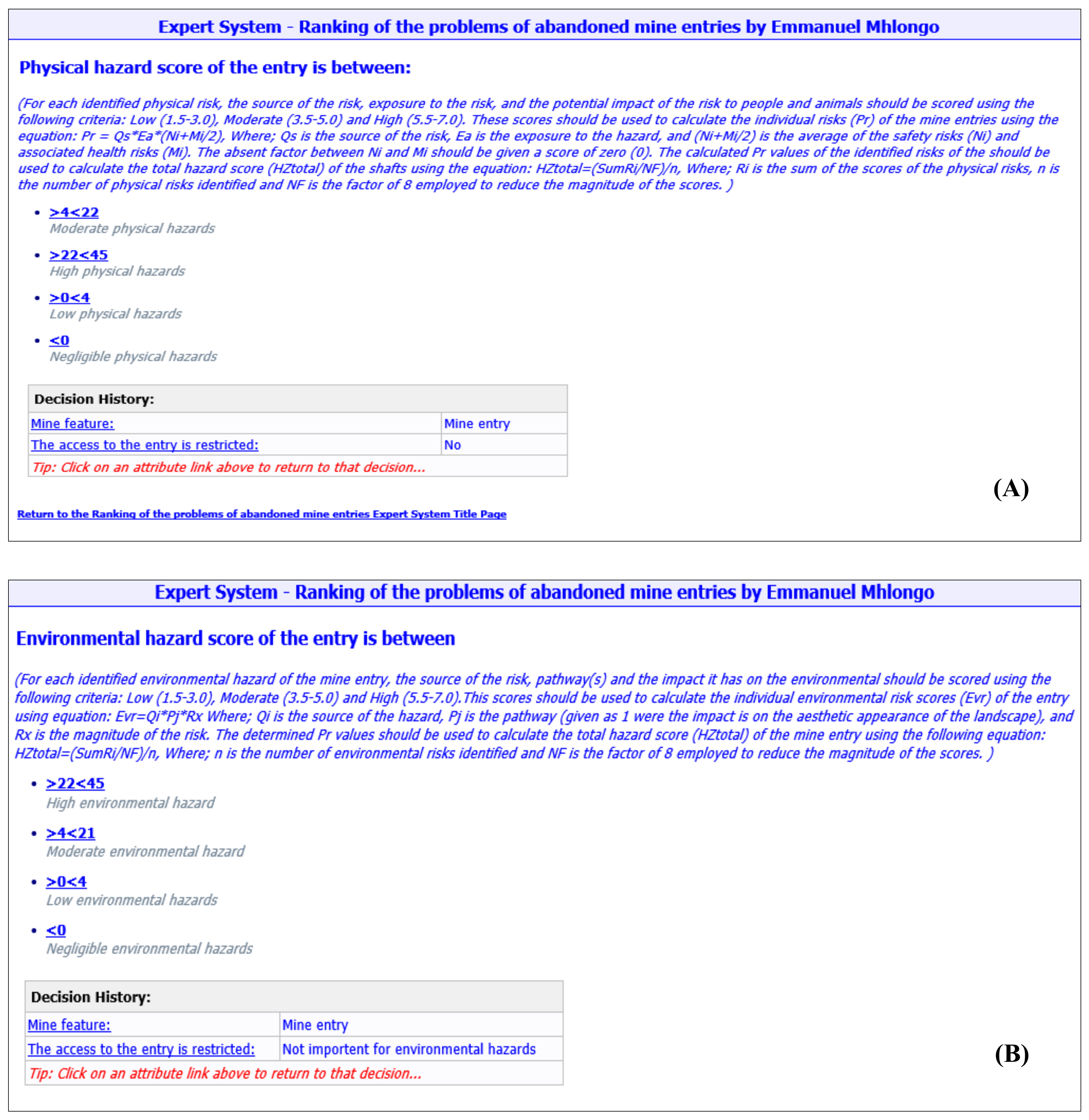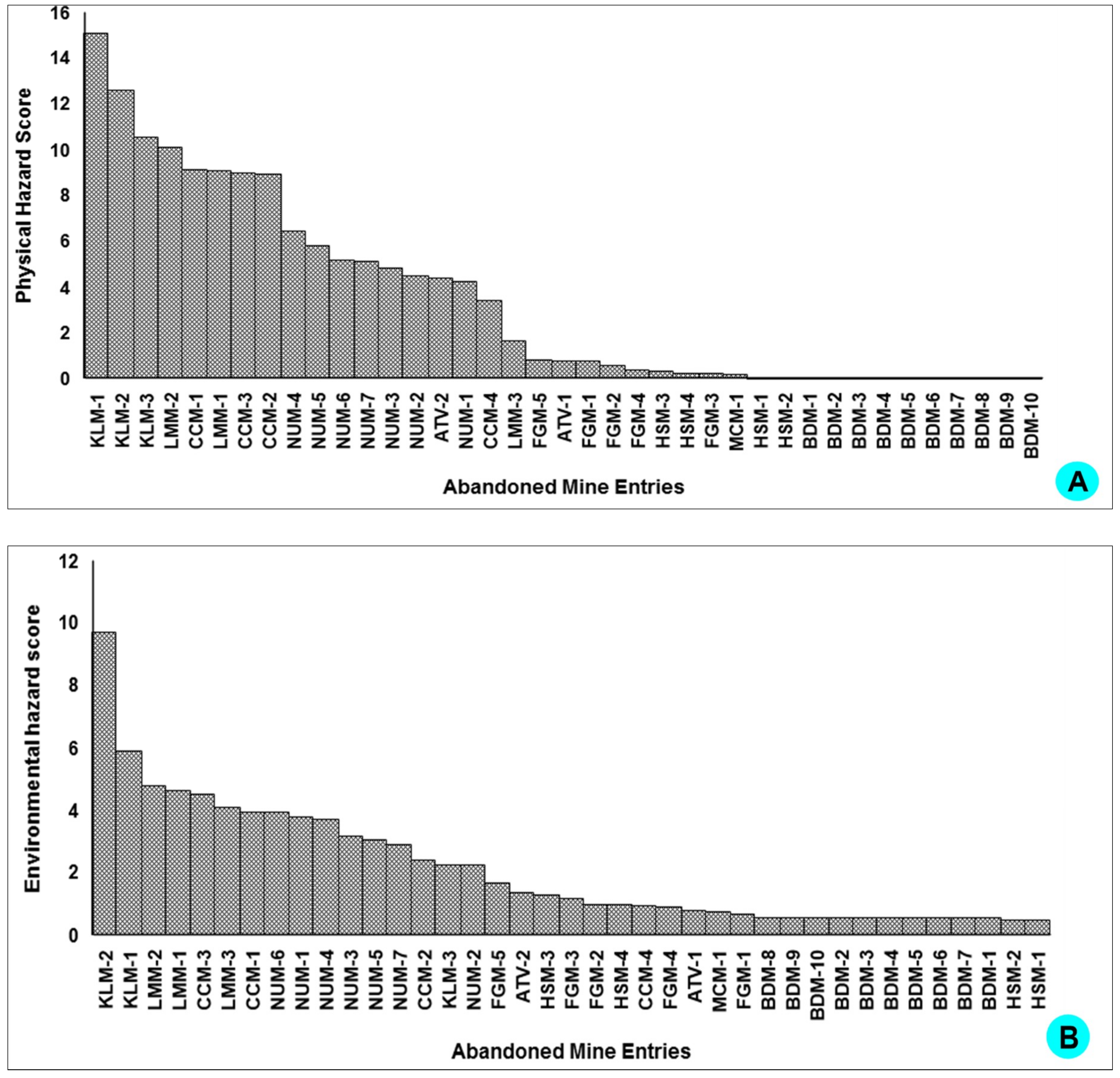1. Introduction
An expert system (ES) is a computer program that deals with decision making in a specific field of knowledge [
1]. It is a branch of artificial intelligence (AI) that uses knowledge and inference procedures to solve problems that generally require human expertise [
2]. Expert systems mimic the behavior of human experts [
3]. They can be created from information gathered from experts or using model-based information [
4]. According to Lucus [
5], the term expert system was coined based on the fact that these systems were developed with collaboration with experts during the early days. Currently, shells are used to create an expert system. The expert system shell is basically a computer program that, when supplied with a knowledge base, yields an expert system. It reasons with the knowledge in the knowledge base to produce conclusions that are based on entered facts, which seriously reduces the amount of time and labor required for creation of an expert systems. In general, the shells eliminate the need for programming the rules of the expert system using programming languages such as C/C++ and Cobal [
6]. Some of the common expert system shells includes the Art Enterprise, EXSYS CORVID, MP2, Clips, ES-Builder, JESS, AION-DS, EMYCIN, MYCIN, and PROLOG [
5,
7].
The application of the method for ranking the hazards of abandoned mine shafts into the expert system reported in this paper is achieved by using an ES-Builder Shell©2013 McGoo Software. This shell has the advantages of being user friendly, motivating, and compatible with Microsoft Windows [
8]. Like other web-based expert system shells, the ES-Builder is commonly used to design expert systems that are accessible as web pages and can be easily incorporated as a knowledge base in the web page [
9]. In general, the development of the expert system using the internet technology makes the design and accessibility of the ES easy [
10]. The factors that make the internet the best platform for expert system delivery were identified by Grove [
11] to be that (i) the internet is readily available, (ii) web-browsers provide a common multimedia interface, (iii) several internet portable tools for knowledge-based systems development are available, (iv) internet-based applications are inherently portable, and (v) emerging protocols support co-operation among knowledge-based systems [
12].
The Description of the Problems of Abandoned Mines and the Case Study
In South Africa, abandoned mines are referred to as those mines for which a closure certificate has not been issued and no party can be traced to assume responsibility for their liabilities; as a result, the funds for their rehabilitation are provided by the government [
13,
14]. Abandoned mines are also considered a costly legacy of previous mining operations that were conducted with no regard for the environment and its protection. Generally, they are found in all countries and/or regions that have a long history of mining. Moreover, they are known for their physical and environmental hazards, which are associated with a magnitude of socio-economic issues. In general, the work of addressing the problems of abandoned mines is concerned with making decisions on which areas to rehabilitate first or which strategies or approaches to use in the rehabilitation work. In view of this, there has been an increase in the amount of research work aimed at developing tools, methods, and/or techniques for the prioritization of the rehabilitation of abandoned mines throughout the world. Some of the published commonly used methods for the prioritization of the rehabilitation of abandoned mines are shown in
Table 1 [
15]. This paper presents the work conducted with the purpose of implementing the method for ranking the problems of abandoned mines in the rule-based expert system. Such a system has been tested by applying it to the situation of abandoned mine entries in the Giyani and Musina areas, Limpopo Province of South Africa.
The areas of Giyani and Musina are characterized by several abandoned underground gold and copper mines. As a result, the landscapes of these historic mining areas have different features, including the mine entries or shafts that were treated using different methods and materials. These entries or shafts present different physical and environmental hazards. Some of the mine entries in the study areas have never been treated, while treatment or structures used to close some of them have been removed or destroyed by the illegal artisanal miners operating at these sites [
16]. The methods used to treat the mine entries in order to reduce or eliminate their physical and environmental hazards include concrete slabs, concrete plugs, a combination of slabs and steel wire screens, heavy steel grate, and steel wire screens. The current state and use of these strategies are summarized in
Table 2 [
17]. The location of the shafts in the study area is shown in
Figure 1.
2. Methodology
The development of the expert system for ranking the problems of abandoned mine entries (ES-RAME) began with the acquisition of actual knowledge about the problems of the mine entries. This information was collected through intensive review of literature and field characterization of the mine entries in the study area. This knowledge was used in creating the production rules and the knowledge base of the ES-RAME. These rules were developed based on the procedures of the method for ranking the problems of abandoned mine entries developed by [
14]. The rules and the knowledge base of the ES-RAME were created in the ES-Builder Shell©2013 McGoo Software (ES Builder 3.0, McGoo Software, Philippines) through the development of the decision tree of the expert system. According to Zuhra et al. [
8], the decision tree is basically a graphical depiction of the knowledge and production rules. In this work, the decision tree was developed by entering the Attributes, Values, and Conclusions in the decision tree model provided by the ES-Builder Shell. The tree was created to have nodes that twigged to other nodes until the conclusion was reached or until the tree was complete. The basic rules that need to be followed when formulating an acceptable decision tree in the ES Builder Shall were satisfied [
9]. These rules are summarized and presented in
Table 3.
The use of the ES-RAME requires that field characterization and description of the mine entries are conducted. The purpose of such characterization is to establish in-depth knowledge and understanding of the physical and environmental hazards presented by the entries and to identify and quantify their associated socio-economic issues. This is important for the establishment of the site-specific issues of the abandoned mine entries. The knowledge of the problems of the mine entries generated through this process is also important for accurate scoring of the factors of the physical and environmental hazards of the mine entries. These factors were (i) the source of the hazards, (ii) the ways of exposure/pathways of the hazards, and (iii) the magnitude of the potential damage that the hazards may cause. Based on the scoring process, the environmental and physical risks of the mine entries as well as their socio-economic concerns were quantified. The magnitude (as was defined by the calculated scores) of the individual risks of the mine entries was then used to calculate the total hazard score, which was used by the expert system to classify the problems of the mine entries into four categories, namely; Negligible, Low, Moderate and High. The basic framework of the method that followed in the formulation of the production rules of the ES-RAME is shown in
Figure 2.
3. Results
3.1. The Production Rules of the ES-RAME
The decision tree created for the ES-RAME assisted in coming up with nine conclusions, as shown in
Figure 3. The conclusion statements given by the expert system are shown in
Table 4. The example of the production rules of this expert system made it possible that the environmental and physical hazards of the abandoned mine entries, together with their associated socio-economic concerns, could be ranked into four categories, which are High, Moderate, Low, and Negligible. This caused the decision tree developed for the expert system to be broadly divided into three branches, the first of which was responsible for the ranking of the physical hazards and social concerns of the mine entries, while the other assisted with the ranking of the environmental and economic impacts of the mine entries. The third branch of the decision tree was created to rank the mine entries in the situations where there was restricted access to the entries or the abandoned mine site at large.
In general, the developed production rules of the expert system are stored in the knowledge base of the system. The structure of the knowledge base of the ES-RAME with its production rules is shown in
Appendix A. It is important to indicate that the production rules allow the user of the ES to arrive at a given conclusion, which is also displayed in the conclusion page of the expert system. An image that provides clues to the situation of the abandoned mine entry for which the conclusion is made is also displayed in the conclusion page of the expert system. An example of the conclusion pages of the ES-RAME is shown in
Figure 4a,b.
In addition, the implementation of the method of ranking the problems of abandoned mine entries into the expert system shell made the system work in an interactive manner. In this, the user collected site-specific information about the mine entries and follows the guidance of the expert system in ranking hazards of the entries. This characteristics of the ES-RAME enabled easy use of the expert system in the manner that accommodated site-specific issues of the abandoned mine entries in the ranking process. They allowed the user to score the factors of the hazards or risks of the mine entries according to his/her field judgment of the situation on site. In this case, the user of the system was assisted by the expert system with the criteria for scoring the factors of the identified physical and environmental hazards of the mine entries. The ES-RAME also provided the description of the procedure for calculation of the total physical and environmental hazard scores of the abandoned mine entries. The instruction given by the ES-RAME on the process of the calculation of the environmental hazard scores is shown in
Figure 5A, while that for calculation of the physical hazard scores is shown in
Figure 5B. The general attributes of the ES-RAME are presented in
Appendix B.
Based on the determined physical and environmental hazard scores, the ES-RAME provide guidance on the ranking of the hazards. In each category of physical and/or environmental hazards, the ES-RAME was created to provide recommendation of the aim or objective of the mine entry treatment work. It is important to mention that the development of the decision tree and the production rules of the ES-RAME are based on the assumption that the environmental and physical hazards of abandoned mines are associated with the socio-economic concerns of these mines. This is because the environmental problems of the abandoned mines tend to result in the poor economic development of the area, while their physical hazards affect mostly the social well-being of the people residing around the abandoned mine sites. In view of these, the ES-RAME concluded by combining the physical hazards with social concerns of the mine entries and the environmental hazards with the economic issues of the host communities.
3.2. Application of the ES-RAME to the Mine Shafts of Giyani and Musina
The developed rule-based ES-RAME was applied to the situation of abandoned mines in the areas of Giyani and Musina in the Limpopo Province of South Africa. The results of the ranking of the physical and environmental hazards of the mine entries in the study area are shown in
Figure 6A,B. The ranking process demonstrated that the physical hazards of shafts in the two areas ranges from negligible to moderate levels. In this case, the physical hazard scores of the mine entries ranged from the minimum of 0.04 to the maximum of 15.09 (see
Figure 6A). On the other hand, the environmental hazard scores ranged from 0.47 to 9.67, which resulted in the classification of these hazards ranging from low to moderate levels (see
Figure 6B).
Based on the physical and environmental hazards score of the mine shafts, the ES-RAME classified the socio-economic concerns of the mine shafts in the Giyani and Musina areas so that they ranged from negligible to a moderate. In this case, the mine shafts that were recently treated or closed using both backfilling and installation of concrete plugs had negligible physical hazards while mine shafts that had minor ground movements were found to have low environmental problems. Most of the mine shafts that were treated/closed using concrete slabs and those that were found open were classified as having low and moderate socio-economic concerns, respectively. The mine shafts that had relatively elevated socio-economic concerns in the moderate category were the open openings that were in unstable grounds around Musina and the inclined shafts that were being entered by the illegal gold miners in the Giyani area. The guidance given by the expert system in terms of what should be the focus of the treatment work in these mine shafts as captured in the conclusion pages of the ES-RAME is shown in
Table 5.
3.3. Implication for Treatment of the Mine Entries
The analysis of the situation of the abandoned mine entries conducted in this research showed that these entries are generally characterized by noticeable levels of physical and environmental hazards. These hazards also have impact on the social and economic development of the host communities and/or the whole region where the abandoned mines are found. As a result, it is important that these concerns or problems of the abandoned mine entries be addressed through a progressive implementation of short- and long-term treatment strategies. Since there is generally gradational or overlapping contact between the categories of the problems of the mine entries, the implementation of the treatment strategies can be in a manner that overlaps, as shown in
Figure 7.
In this case, for the mine entries that have half score of the negligible category of the hazards to the half score in the category of low hazards, the treatment should focus on maintaining and repairing the failing or collapsing structures previously adopted in the treatment of the mine entries. Moving from low to moderate hazard categories, the treatment of the entries should mostly use structures that temporarily close the mine entries. The implementation of the strategies that provide permanent closure of the abandoned mine entries is to be considered in the case of mine entries that have hazard scores that are half way between the moderate and high categories. A graphical illustration of the recommended implementation of the treatment strategies for abandoned mine entries and the focus of the treatment efforts is shown in
Figure 7.
4. Discussion
Abandoned mines are found in all countries and regions with long history of mining. The work of addressing the problems of these mines involves making several key decisions that mostly revolve around which features or sites are to be rehabilitated first and which strategies to use in the rehabilitation work. This is crucial, since the rehabilitation of these mines is mostly conducted with limited resources. Therefore, the accuracy of prioritization of the rehabilitation work coupled with the selection of the best approaches for rehabilitation of these mines have a potential to ensure that sustainable management of abandoned mine sites or features is achieved.
In view of this, different countries, individual researchers, and organizations have been making efforts to develop easy-to-use decision-making tools for rehabilitation of abandoned mines. In all attempts to develop such decision-making tools, the first tool that was developed in the form of an expert system was the tool known as the Abandoned Mines Hazard Ranking System—AMHAZ [
30]. This tool used multi-criteria and pairwise comparison to rank the abandoned mine sites for rehabilitation. It did this based on the factors such as public safety and health, environmental problems, and socio-economic concerns [
26].
In this research, the method for ranking the problems of abandoned mine entries was developed and incorporated into the web-based expert systems. The method ranks the problems of abandoned mine entries using the decision rules that are built into the knowledge base of the expert system shell. The incorporation of this expert system in the ES-Builder©2013 McGoo Software made it possible and simpler to create the web-link (i.e., URL) though which the ES-RAME can be accessed. Using this link, the ES-RAME can be published as a stand-alone expert system through sharing and following the link, or it can be published on the special website designed for such a purpose. The characteristics of the ES-RAME are shown in
Table 6.
5. Conclusions
In this work, a web-based expert system for advising in the ranking of the problems of abandoned mine entries was developed. The system was comprised of the decision tree and production rules that assist in the ranking of the problems of abandoned mine entries. Its functionality was tested by applying it to the ranking of the problems of abandoned mine entries in the areas of Giyani and Musina, Limpopo Province of South Africa.
The implementation of the methodology for ranking the problems of abandoned mine entries into the expert system created using the web-based ES-Builder©2013 McGoo Software made the developed ES-RAME easily available and accessible in and through the internet. The major advantage of implementing the abandoned mines ranking method in the rule-based expert system is that preliminary ranking can be easily conducted using fictitious or basic information about the situation of abandoned mine entries. Such preliminary or trial runs of the expert system can give the user a feel of and/or insight into the ranking process used by the system. It also provides the user with a clear understanding of the nature of information that is required for the actual ranking of the problems of the abandoned mine entries.
The ranking of the problems of abandoned mine entries using the ES-RAME also allows for the objectives of the treatment of the entries to be identified. This then ensures that the safety status of the abandoned mine entries is improved through the execution of appropriate strategies for dealing with their identified specific issues. These characteristics of the ES-RAME will go a long way in reducing the rehabilitation cost normally associated with use of unsuitable strategies for the problems of abandoned mines. The use of this system has the potential to assist or contribute to the sustainable management of the rehabilitation or treatment of abandoned mine entries in different parts of the world where they are found.
Author Contributions
This paper was written from the ongoing PhD work at the University of Vanda. S.E.M., F.A.-D., and A.K. contributed to the conceptualization of the work. Moreover, S.E.M. developed the expert system and wrote the first draft of this manuscript. F.A.-D. and A.K. supervised the development of the expert system and edited the manuscript.
Funding
This research did not receive any external funding. The fieldwork of the research was financially supported by the Office of the Vice Chancellor Academic (University of Venda) through the Capacity Development Grant (Grant Specific Number D027). The Article Processing Charges (APC) was funded by the Research and Publication Committee (RPC) of the University of Vanda.
Acknowledgments
The authors would like to acknowledge the assistance of C Muzerengi and GK Pindihama in conducting the field work part of this research. They are also grateful to the McGoo Software for making the ES-Builder Shell freely available online and for the constant guidance provided on different aspects of using the Shell. The authors also acknowledge the Dean (JO Odiyo) of the School of Environmental Sciences (University of Venda) for organizing the writing workshop that assisted in the reshaping of this paper.
Conflicts of Interest
The authors declare no conflict of interest.
Appendix A.
Figure A1.
The knowledge base rules of the ES-RAME.
Figure A1.
The knowledge base rules of the ES-RAME.
Appendix B.
Figure A2.
The list of the attributes of the ES-RAME.
Figure A2.
The list of the attributes of the ES-RAME.
References
- Burhan, A.M. Developing an expert system for the investigation of construction failure causes by using es builder program. Appl. Res. J. 2016, 2, 43–49. [Google Scholar]
- Gunawan, E.P.; Wardoyo, R. An expert system using certainty factor for determining insomnia acupoint. Indones. J. Comput. Cybern. Syst. 2018, 12, 119–128. [Google Scholar] [CrossRef]
- Duana, Y.; Edwards, J.S.; Xu, M.X. Web-based expert systems: Benefits and challenges. Inf. Manag. 2005, 42, 799–811. [Google Scholar] [CrossRef]
- Jain, R. Expert systems: A management perspective. Vikalpa 1989, 14, 17–28. [Google Scholar] [CrossRef]
- Lucas, P. Expert Systems; Encyclopedia of Life Support Systems (EOLSS): Abu Dhabi, UAE, 2004; p. 9. [Google Scholar]
- Salim, M.D.; Villavicencio, A.; Timmerman, M.A. A Method for evaluating expert system shells for classroom instruction. J. Ind. Technol. 2003, 19, 1–11. [Google Scholar]
- Eldrandaly, K. An Intelligent MCDM approach for selecting the suitable expert system building tool. Int. Arab J. Inf. Technol. 2007, 4, 365–372. [Google Scholar]
- Zuhra, F.T.; Arai, A.A.; Tuni, M.A. An implementation of expert system for orthopedic patient diagnosis. Quaid E Awam Univ. Res. J. Eng. Sci. Technol. 2016, 15, 40–45. [Google Scholar]
- Matthew, O.; Buckley, K.; Garvey, M.; Moreton, R. Multi-tenant database framework validation and implementation into an expert system. Int. J. Adv. Stud. Comput. Sci. Eng. 2016, 5, 13–21. [Google Scholar]
- Hogo, M.A.; Fouad, K.; Mousa, F. Web-Based expert system for civil service regulations: RCSES. Int. J. Comput. Sci. Inf. Secur. 2009, 6, 7–16. [Google Scholar]
- Grove, R. Internet-based expert systems. Expert Syst. 2000, 17, 129–135. [Google Scholar] [CrossRef]
- Mhlongo, S.E.; Amponsah-Dacosta, F. A review of problems and solutions of abandoned mines in South Africa. Int. J. Min. Reclam. Environ. 2016, 30, 279–294. [Google Scholar] [CrossRef]
- Auditor-General South Africa. Report of the Auditor-General to Parliament on a Performance Audit of the Minerals and Energy; Auditing to Build Public Confidence; AGSA: Pretoria, South Africa, October 2009. [Google Scholar]
- Mhlongo, S.E.; Amponsah-Dacosta, F.; Kadyamatimba, A. Development and use of hazard ranking system for abandoned mine entries: A case study of the mine shafts in Giyani and Musina Areas of South Africa. Cogent Eng. 2018, 5, 1–19. [Google Scholar] [CrossRef]
- Mhlongo, S.E.; Amponsah-Dacosta, F.; Muzerengi, C.; Gitari, W.M.; Momoh, A. The impact of artisanal mining on rehabilitation efforts of abandoned mine shafts in Sutherland goldfield, South Africa. Jàmbá J. Disaster Risk Stud. 2019, a688. [Google Scholar] [CrossRef] [PubMed]
- Mhlongo, S.E.; Amponsah-Dacosta, F.; Kadyamatimba, A. Appraisal of strategies for treatment of abandoned mine shafts in the Giyani and Musina areas of Limpopo Province of South Africa. In Proceedings of the 12th International Conference on Mine Closure, Leipzig, Germany, 3–7 September 2018; Drebenstedt, C., von Bismarck, F., Fourie, A., Tibbett, M., Eds.; Technical University Bergakademie Freiberg: Freiberg, Germany, 2018; pp. 414–424. [Google Scholar]
- Pioneer Technical Services Inc. Abandoned Hard Rock Mine Priority Sites 1994 Summary Report. In Montana Department of State Lands Abandoned Mine Reclamation Bureau; Engineering Services Agreement DSL-AMRB No. 94-006; Pioneer Technical Services Inc.: Butte, MT, USA, 1994; p. 148. [Google Scholar]
- Jordan, G.; Abdaal, A. Decision support methods for the environmental assessment of contamination at mining sites. Environ. Monit. Assess. 2013, 185, 7809–7832. [Google Scholar] [CrossRef] [PubMed]
- Day, S.J.; Harpley, D.P. Survey of closed and abandoned mines in British Columbia for acid rock drainage I: Regional perspective. The Technical and Research Committee on Reclamation. In Proceedings of the 16th Annual British Columbia Mine Reclamation Symposium, Smithers, BC, USA, 15–18 June 1992; pp. 152–161. [Google Scholar]
- Power, B.A.; Tinholt, M.J.; Hill, R.A.; Fikart, A.; Wilson, R.M.; Stewart, G.G.; Sinnett, G.; Runnells, J.L. A risk ranking methodology for prioritizing historic, potentially contaminated mine sites in British Columbia. Integr. Environ. Assess. Manag. 2009, 6, 145–154. [Google Scholar] [CrossRef] [PubMed]
- Tremblay, G.A.; Hogan, C.M. Approaches for the Remediation of Abandoned Mines and NOAMI. Proceedings of Symposium 2008 Rouyn-Noranda, Mines and the Environment, Rouyn-Noranda, QC, Canada, 2–5 November 2008; pp. 1–12. [Google Scholar]
- Luodes, N.M. Inventory of closed and abandoned mines methods for performing the inventory and for risk classification with diverse data availability levels. Bachelor’ Thesis, Mikkeli University of Applied Sciences, Mikkeli, Finland, 2013. [Google Scholar]
- Geological Survey of Ireland and the Environmental Protection Agency. Appendix 1: Historic Mine Site Scoring System (HMS-SS), A Project to Categorize Contamination Sources from Mine Waste at Historic Mine Sites; Geological Survey of Ireland and the Environmental Protection Agency: Dublin, Ireland, 2009; p. 51.
- PGeo, E.G.S.; Gallagher, V.; Mhairtín, F.N.; Brogan, J.; Lally, P.; PGeo, E.E.D.; PGeo, E.L.F. Geochemical Characterization and Environmental Matters Historic Mine Sites—Inventory and Risk Classification: A Joint Study Carried out by the Environmental Protection Agency and the Geological Survey of Ireland; The Geological Survey of Ireland: Dublin, Ireland, 2009; Volume I, p. 170. [Google Scholar]
- Bolger, P.M.; Duszak, Z.; Koczkodaj, W.W.; Mackasy, W.O. Big problems/small problems? Applying ‘first things first’ principle towards establishing a management system (AMHAZ) for prioritizing abandoned mine hazards. In Proceedings of the Sudbury 95, Conference on Mining and Environment, Sudbury, ON, Canada, 28 May–1 June 1995; pp. 339–348. [Google Scholar]
- Mackasey, W.O. Abandoned Mines in Canada; WOM Geological Associates Inc.: Sudbury, ON, Canada, 2000; p. 14. [Google Scholar]
- Kubit, O.E.; Pluhar, C.J.; De Graff, J.V. A model for prioritizing sites and reclamation methods at abandoned mines. Environ. Earth Sci. 2015, 73, 7915–7931. [Google Scholar] [CrossRef]
- Chaumba, J.B.; Mundalamo, H.R.; Ogola, J.S.; Cox, J.A.; Fleisher, C.J. Petrography, sulfide mineral chemistry, and sulfur isotope evidence for a hydrothermal imprint on Musina copper deposits, Limpopo Province, South Africa: Evidence for a breccia pipe origin? J. Afr. Earth Sci. 2016, 120, 142–159. [Google Scholar] [CrossRef]
- Parnham, D. Creating shareholder value in South Africa and Canada, Unlocking value in the Limpopo Provence; Giyani Gold Corp: Oakville, ON, Canada, 2015; p. 21. [Google Scholar]
- Duszak, Z.; Koczkodaj, W.W.; Mackasey, W.O. Towards better abandoned mine hazard prioritization an expert system. In Proceedings of the 10th National Meeting of ASSMR, Spokane, WA, USA, 16–19 May 1994; pp. 577–590. [Google Scholar]
© 2019 by the authors. Licensee MDPI, Basel, Switzerland. This article is an open access article distributed under the terms and conditions of the Creative Commons Attribution (CC BY) license (http://creativecommons.org/licenses/by/4.0/).
